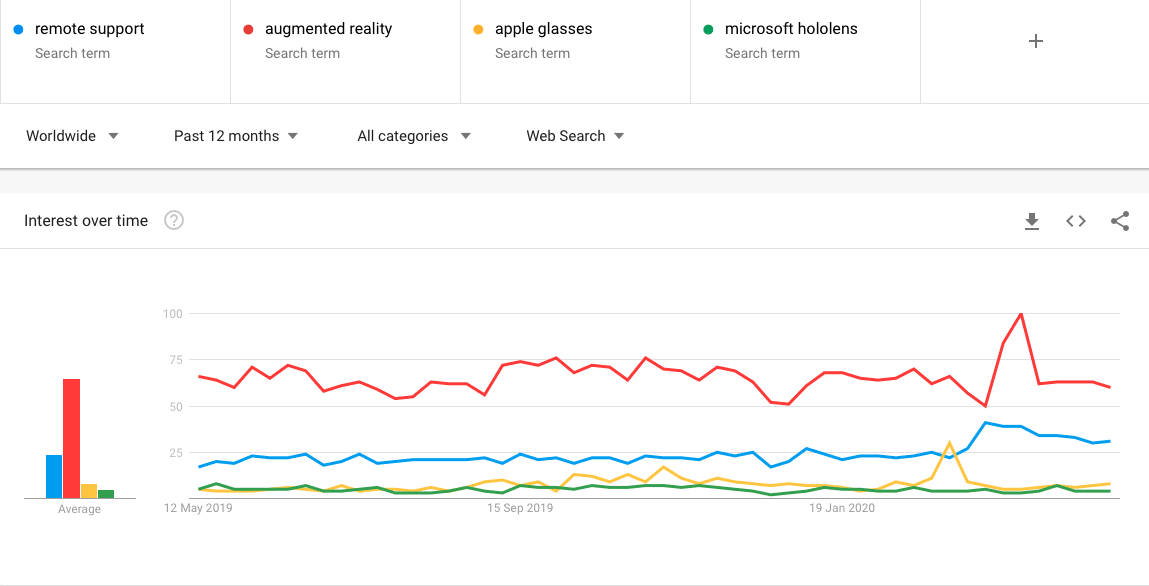
This article is the latest in AR Insider’s editorial contributor program. Find out more or contact us to participate here. Authors’ opinions are their own.
New technologies often follow a common course, starting with initial hype followed by a longer phase of sideways movement, then finally a breakthrough. We see this development in technologies such as Augmented Reality (AR), Virtual Reality (VR) and Blockchain. Still, many startups that build products in new markets wonder why adoption isn’t as fast as expected.
AR is a good example of this. I’ve been working with AR and VR for 10 years during which I’ve seen the ups and downs and shifting success factors. Researched in the 1970s, and anticipated through the new millennium, it still doesn’t pass the toothbrush test: “Will people will use at least once a day, and will it make their lives better?”
Even though there are numerous use cases that demonstrate how AR makes life and work easier, daily use is still lacking. The added value is evident, but adoption was still slow. Why is that?
Adoption = Value + Urgency
If you look at AR in the enterprise sector and compare it with Geoffrey Moore’s “Crossing the Chasm” construct, it is easy to see that the market is in the middle of the chasm. AR has already left the early adopters and is freeing itself more and more from the ranks of the innovation labs. The first scalable platforms and roll-outs at large companies have begun, and adoption is slowly but surely increasing.
For startups, this means a moving target because the buyers have different demands – from innovation labs to larger enterprise rollouts. As pragmatic buyers, companies expect a mature software solution that meets the requirements for security, integration and scalability. These factors join value urgency and user experience as crucial components. While users in labs are already experimenting, pragmatic buyers expect an easy-to-use and “turnkey” application.
Before the coronavirus crisis, the lack of urgency was one of the reasons why AR didn’t get off the mark. Change cannot be achieved gradually, and the pain was obviously not big enough to replace existing tools, even though the problems were known (difficult to understand instructions for complex tasks, wasted time searching for information, unnecessary travel costs for experts, etc.).
Urgency is a Catalyst for Change
An MIT study about embracing digital technology reports that 63 percent of surveyed managers said the pace of technological change in their workplaces is too slow, primarily due to a “lack of urgency.” Employees need to understand why the new technology is an improvement from what they had before. We could see the latter in some use cases, but it was not enough to achieve the necessary urgency and establish AR on the market. From my previous experience with emerging technologies, the value has to be even more obvious and sometimes external effects are needed – especially if the new technology requires a major change.
“From one day to the next, our world–and thus the way we learn and work–has changed completely. Travel and access restrictions have led to rethinking and thus created the missing element: urgency.”
From one day to the next, our world – and thus the way we learn and work – has changed completely. Travel and access restrictions have led to rethinking and thus created the missing element: urgency. Companies can no longer fulfill service contracts, in-person training can no longer take place, on-site sales demos and events are canceled. And the solution: remote work and support. Instead of “in-person”, we experience a shift to “on-demand.” Mary Meeker describes in her report “Our new World” how this principle will apply in the long term to key enterprise segments like training and healthcare.
The Rise of Remote
Remote collaboration tools were in the sights of companies from one day to the next, and we see enormous growth, particularly in the case of conferencing tools. The best example is Zoom. According to Business of Apps, Zoom had 10 million meeting participants in December 2019, exploding to around 300M in April 2020. Monthly Active Users (MAU) rose from 10.7 million to around 13 million in the same period. A much smaller increase, where the actual conversion is still pending because many users only get to know what the new normal means.

Google Trends indicates a smaller impact for the term “Augmented Reality,” while “Remote Support” shows much stronger relevance. However, it’s important to keep in mind that “remote support” includes AR solutions as well as traditional video calls. In our own data at RE’FLEKT, we see an increase in the MAU of about 300 percent for remote support tools across all industries. In some cases, the peak increase is 600 percent. The increased number of requests as well as the growing user base was confirmed by my sources at other AR startups and vendors.
A key finding is that many users currently do not differentiate between classic conferencing tools and AR support. Both categories use video calls but solve different problems. Even if the Google Trends do not yet make a significant statement about the medium-term development, it’s clear that the market will differentiate and thus create new fields for AR in which startups can move. Remote AR 4.0 will be able to focus more on the new problems in companies and users than before.
What does it tell us?
1. AR will benefit more from the urgency in 2020 than VR
AR is addressing the broader market compared to VR. Even though smart glasses and VR headsets have the capacity to solve current Covid-19 challenges (depending on bottlenecks in manufacturing), it is phones and tablets that are immediately ready for instant use. Existing devices do not have to be bought or approved. In addition to Covid-19 as a change driver, there is an existing and broad mobile market as a basis for technology adoption.
2. Remote AR will become the catalyst for all spatial computing fields
Remote AR can empower far-flung workers with the live and on-demand support of colleagues, making everyone an instant expert by placeshifting knowledge. Although it is still early for a meaningful trend, there’s a growing number of active users in the past four weeks. While remote tools are hot during Covid-19, the entire AR and VR market reveals new use cases and gives new meaning to existing ones (e.g. the long-explained advantage of AR in training and operating complex devices such as ventilators in hospitals). This can lead to increased acceptance of further areas of application of AR and VR and to present the long-awaited killer app (even if I personally do not find the term suitable).
3. Fast track adoption needs user experience to survive
Urgency is the trigger for faster adoption of emerging technologies, but without easy operation and good user experience, growth is quickly over. Zoom is the best example of this–it just works. Although there have been some problems in the past few weeks, the users are convinced of the simplicity and stability. Zoom leaves Microsoft miles behind with Skype and teams. Exactly that was one of the obstacles with AR and also with VR because the technology was mostly in the foreground.
4. Higher education level will force startups to build products for the market
In 2020, we will see users learning more about their own requirements for AR and VR (software and hardware). They will know exactly what they need. The feedback collected so far is mostly unstructured and not meaningful due to the too-small user base. Startups have to use the phase during Covid-19 in order to better understand where AR / VR can be used today and tomorrow and to develop the right products. Covid-19 not only brings spatial computing to urgency but also to a growing market (not in 2020). This will make it easier to go into specific use cases instead of getting stuck in endless trial phases. Remote support has a much lower level of explanation than other AR and VR applications.
5. Reverse effect from the enterprise sector into consumer markets
Anyone who uses AR at work will soon no longer want to connect or set up a router or IKEA shelf without AR. We often see the opposite picture: early adopters find new technologies and innovations that carry it into the business sector. This has not worked for AR and VR so far because the entry was too complex, the hardware is still too expensive and individual highlights such as Pokémon Go or the Oculus Quest could not change a complete market – what Apple will do. In the business sector, many users experience how practical remote support is while Covid-19. Behavioral change comes from the business sector and will have a significant impact on the consumer market.
“Augmented Reality will become as normal as eating three meals a day”
—Tim Cook, 2016
To stick with Tim Cook’s quote, we are still setting the table. Today we are at the first course (remote AR). The missing ingredients for the main course are brought, and by 2021 we will have the full pleasure before the dessert is served. Tim will play an important role as one of the main chefs – not only to build hardware and ecosystems, but above all to take the previously hesitant investors on the trip.
Big players have the potential to change markets and push technologies. Apple completely turned the mobile age upside down in 2007, Microsoft shaped the way we work on computers. It is precisely in these times that there are great opportunities for startups. Salesforce changed the market for CRM software and paved the way for the cloud in the late 1990s while the internet bubble was in full swing. And Zoom, yes, the startup folks that make video calls easy have made Skype almost forgotten.
When I started my AR journey ten years ago, smartphones weren’t built for the technology, users didn’t know what we were talking about (but were enthusiastic). Since then, we have made a big leap and as a startup, we have mastered many of the challenges that a new market brings with it. Startups that develop products with new technologies face their own problems that they have to solve. The next two years will be decisive for AR and VR. AR seems to be finding its place in the “augmented workplace.” How exactly? We will find out in the coming months.
 Dirk Schart is CMO and President of RE’FLEKT.
Dirk Schart is CMO and President of RE’FLEKT.
